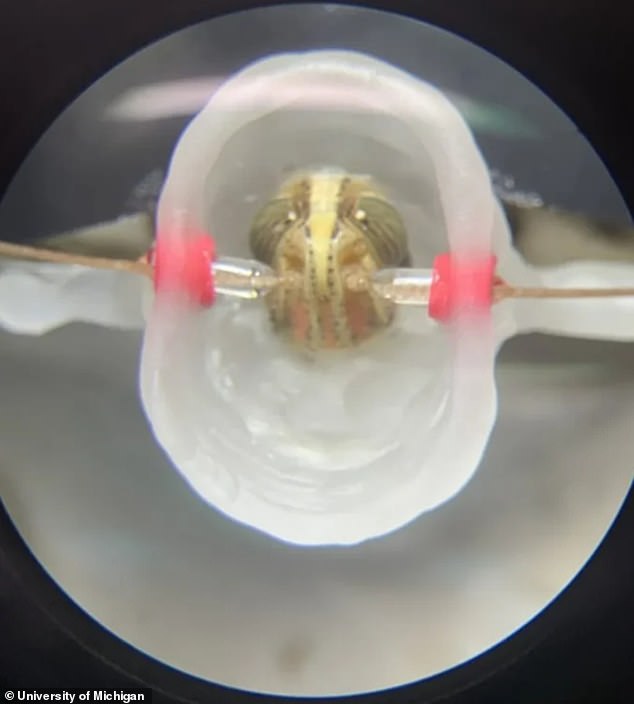Locusts could be used to “sniff out” cancer in humans, scientists have suggested after experiments on the insect’s brain.
Researchers at Michigan State University found that the animals could tell the difference between cells that caused three types of oral cancer and non-cancerous cells.
They said the technique could offer a "very rapid" alternative to standard screening for cancer detection, with methods currently relying on swabs and scans in a laboratory.
Previous studies have seen animals ranging from dogs to ants used to detect cancer in humans, but the research has rarely progressed because scientists struggle to find commercial use for this type of work.

Grasshoppers could be used to detect cancer in humans, Michigan University scientists say (File)

Pictured above is one of the grasshoppers in the study. Scientists exposed her brain and inserted electrodes. They then exposed the antennae (left and right by the pink rings) to gases released via cancer cells
The study was published as a preprint in BioRxiv pending peer review prior to publication in a medical journal.
The researchers exposed the insect's brain and then placed electrodes in the areas connected to the antennae - which detect smells.
Gases emitted from three types of oral cancer cells were then captured, as well as from a non-cancerous cell from the same area.
These were exposed to the antennae and scientists monitored the insect's brain for a response.
The results showed that each cancer triggered a unique electrical signal in the beetle's brain.
The non-cancerous cells also had their own unique signal.
Dr. Debajit Saha, the biomedical engineer who led the study, and others wrote in their paper: "Our results show that three different human oral cancers can be clearly distinguished from each other and from a non-cancer... by eliciting olfactory responses from the insect's antennal lobes."
They said the method was “sensitive,” “reliable,” and “very fast.”
However, because the experiment required up to 40 neurons, the team had to uncover six to ten locust brains.
This is what the scientists behind the method said MIT Technology Review that they were working to reduce this number.
But Professor James Covington, an engineer at Warwick University in Britain who was not involved in the research, warned that they should reduce the number.
"The bees [used to detect explosives] have a nice life afterwards," he said. "But for these grasshoppers, it's kind of a one-shot deal."
It wasn't clear how well the method would work on other types of cancer, or whether the locusts could smell the cancer in urine, breath or sweat - how it is typically detected.
Current methods of detecting cancer rely on swabs, which provide results two to 10 days later, and scans of areas that may be affected.
Previous research has shown that dogs could be used to detect several types of cancer, including those in the chest and lungs, by sniffing patients' breath.
French scientists have even found that ants can be trained to recognize cancerous and non-cancerous cells.
According to official estimates, approximately 54,000 Americans are diagnosed with oral cancer each year.
Overall, 60 percent of those affected survive longer than five years after diagnosis. But the survival rate is up to 90 percent for those in whom the cancer is discovered in its early stages.

 Suche
Suche
 Mein Konto
Mein Konto

